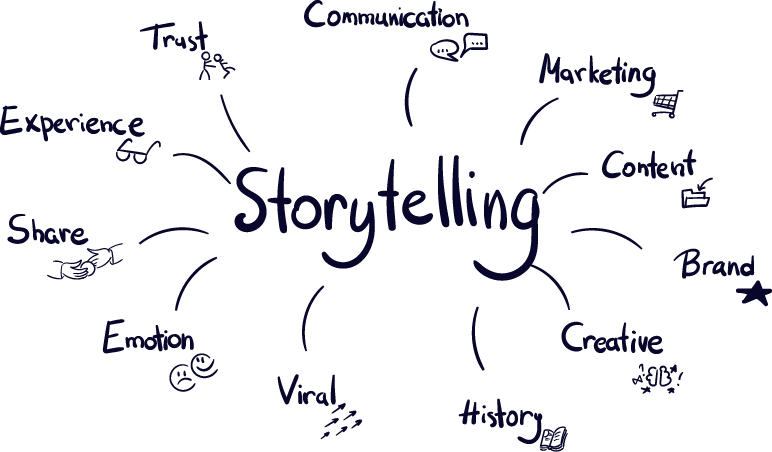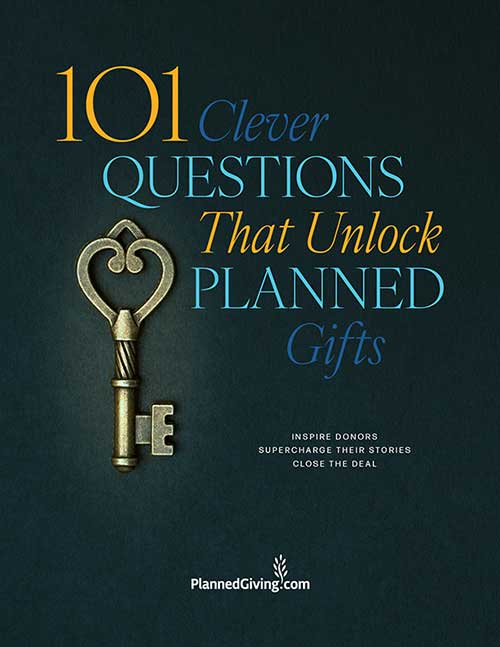The warmth and honesty of a personal donor story rises above the daily barrage of marketing and advertising messages that blast your prospects all day long.
An effective donor story elicits a natural identification process from your prospects.
"That's me!"
is their response as they read it.

And that is exactly where you want them — visualizing a positive outcome for themselves if they, too, make a gift.
In short, donor stories motivate people to give, and in fact, generate second time gifts. Donor stories should be posted on your planned giving website, mailers, and in your Ways-of-Giving brochures.
If you or a staff member will be interviewing donors, here is a wonderful resource you should have.

Storytelling That Sells: How to Move Donors From the Heart to the Will
Introduction: The Power of a Donor’s Story
Imagine this: A quiet professor at a small liberal arts college passes away, leaving his entire estate to the school. For years, no one understood why—until his niece uncovered an old letter. It detailed how a professor had once changed his life, guiding him through difficult times. This one story transformed the estate gift from a transaction into an emotional legacy.
This is the power of donor stories. They inspire, persuade, and create lasting impact.
In fundraising, facts tell, but stories sell. Statistics and tax advantages may educate potential donors, but it’s emotional storytelling that drives action. A well-told donor story doesn’t just highlight generosity—it invites others to see themselves in the narrative and take action.
Why Stories Work When Numbers Don’t
Humans are wired for stories. Research in neuroscience shows that narratives trigger the release of oxytocin, the “trust hormone,” which fosters connection and empathy. Stories activate the emotional centers of the brain, making donors feel connected to a cause on a deeper level.
Contrast this with numbers: Data is logical, but logic alone doesn’t move people. Consider these two messages:
- “Last year, 78% of planned gifts came from bequests, making them the most common vehicle for philanthropy.”
- “When Susan, a retired teacher, included a bequest in her will, she ensured that future students would have scholarships—just like the one that changed her life.”
Which one is more compelling?
People don’t connect with percentages. They connect with people.
What Makes a Donor Story Powerful?
Not all stories are created equal. A successful donor story should have:
- Authenticity – It should be real, honest, and personal.
- Relatability – Readers should see themselves in the donor’s journey.
- Emotion – Whether joy, nostalgia, or even grief, emotion is key.
- Transformation – The donor’s gift should lead to a visible impact.
Example: A former scholarship recipient who later donates to ensure other students receive the same opportunity.
Pro Tip: The best stories aren’t about your nonprofit. They’re about the donor and their personal “why.”
From Storytelling to Storyselling
Robert Ringer and Dan Kennedy emphasize that stories must do more than entertain—they must sell.
This applies directly to fundraising. Stories should transition seamlessly from emotional engagement to a call to action.
A weak story ends with:
“And that’s why James donated.”
A strong story ends with:
“James made a gift that will change lives for generations. How will you leave your legacy?”
Pair emotional storytelling with a clear next step: linking to will planning resources, donor recognition pages, or gift intention forms.
The Anatomy of a Successful Donor Story Page
A donor story should have:
- A Strong Headline – Grab attention immediately (e.g., “How One Gift is Funding Generations of Scholarships”)
- Engaging Visuals – A real photo of the donor (not stock images)
- Concise, Impactful Copy – Short paragraphs, conversational tone
- Clear Call to Action – Encourage readers to plan their own legacy
This format ensures the story moves the reader emotionally while guiding them toward action.
How to Collect Donor Stories Without Sounding Like a Sales Pitch
Many nonprofits hesitate to ask donors for their stories. But most donors are honored to share their legacy.
Best Practices for Outreach:
- Send a warm letter/email after a gift is made.
- Position it as an honor: “We’d love to celebrate your generosity.”
- Keep it conversational. Let the donor talk more than you.
- Show them the final version before publishing.
Bonus tip: Stories can also be turned into short videos, blog posts, and social media content.
Practical Tips for Using Donor Stories Effectively
Here are six tips that will help your nonprofit organization maximize the effectiveness of donor stories. These are the techniques we use when we interview your donors on your behalf.
- Start with a compelling headline. Grab your readers’ attention and don’t let go. Make them want to read more. Remember: The headline is the advertisement for the body copy. Sell that story!
- Use appealing photos to complement your donor story. Study after study shows that pictures draw the eye in a way that text can’t. Work with donors to get photographs (even better yet, videos) that are visually interesting and appealing to your planned giving prospects. If you use stock footage, make sure the people look real (not like models for a dental clinic).
- Craft copy that engages your prospects. Get hold of a good copywriter who can write both for the donor and Google (for SEO — search engine optimization).
- Have a sample questionnaire in front of you. It will help you obtain most, if not all, the details when you speak with the donor. Click here to download one (it’s in Microsoft Word so you can customize it).
- Get Personal. An effective donor story goes beyond the what (amount donated) to reveal the who and the why behind the gift. Who is the donor, really? The story should offer a glimpse into their life, and explain what inspired them to give.
- One final tip: Rarely will a donor write you a donor story (called a testimonial in the business world) that you’ll be able to use as-is. The stories will need to be edited for length, clarity, and to ensure they match the style and tone of your other communications. As we mention above, it’s best to partner with someone who is skilled at writing and communication to craft the donor’s story into a readable message.
Stories Are Your Legacy, Too
Just as donors leave a legacy, so does your organization. And the best way to preserve that legacy—for both sides—is through storytelling.
Your next planned gift might not come from a pitch, a seminar, or a tax guide. It might come from a simple, heartfelt story that moves someone to action.
What’s your next donor story?



